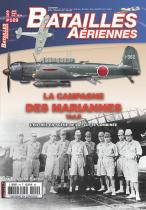The incendiary, night, and low-level bombardments dubbed "Fire Blitz," the number and use of the P-51D escort fighters were the winning combination the Americans found in March 1945 to defeat Japan. But the following month, Operation Iceberg (the invasion of Okinawa) disrupted the plans of XXI Bomber Command, which was tasked with devoting all of its forces in support of this operation to which the Japanese respond with mass Kamikaze action: Operation Kikusui (Floating Chrysanthemum). The "Fire Blitz" on Japan was stopped in mid-April and did not resume until a month later with the phase which would remain in the annals of 20th Air Force under the name of "Bloody Week" ( the bloody week). It is this period "April - May" 1945 that this sixth opus covers with the same attention to detail concerning both camps. As in the previous ones, the B-29 missions are all analyzed with, as a bonus, many testimonials from participants. The reader will thus learn that much more than American might, it is the weakness of the Imperial air force that determines the turn of events. Bleed by the battle of the Philippines and mainly engaged in that of Okinawa, the Japanese fighter, both in material and human terms (it is then mainly composed of young inexperienced pilots), is simply no longer up to the task. of the situation and it is not to her that the heavy losses are attributable, which in May 1945 earned the nickname "deadly month of May" ...
We talk about it in the press and on the Internet.
The B-29 adventure in Japan continues ... with always the same problems on both sides: engine failures that were too stressed, especially on take-off for the Americans, planes that were not performing well enough on the Japanese side ...
The waters of the Pacific cost the lives of many crews and the Kempeï-tai beheaded with all their arms the captured Allied airmen ... And during this time, on both sides, the warlords (Curtis Le May and Admiral Ugaki) delude themselves about their ability to score points against the opponent.
Fans of secret and / or eccentric weapons will note the frantic use by the Japanese of Ta-Dan (air-to-air) bombs while the missions of 23-24 and 25-26 May 1945 see the appearance in the reports of US fighting of the interceptor version of the Baka, Japanese anti-aircraft missiles, and unidentified “fireballs” (Foo-fighters?). The author specifies that the hunting Baka has never been put into service and does not venture to attempt to explain the "fireball" sightings ...
In conclusion: this series on the B-29s on Japan does not disappoint and on the contrary, each episode brings its share of new information (and sometimes questions!) © Modelstories 2021.
- The Air Masters (name given to the aviators of the USAAF) during the second war lost a little of their splendor by believing themselves relatively safe in their flying super-fortresses (appreciation which they repeated during the Vietnam War!) and this against the Japanese much more combative than expected ... and even if the massive bombardment campaign on Japan was gradually bearing fruit and the "victory" seemed inevitable, even if it meant paying an additional bill more in heavy for the whole of the armed forces, it was necessary at all costs to finish the work started in 1942 ... Fortunately that the atomic bomb ended up putting an end to a hemorrhage of men and material considered more unbearable by the opignion public, but this is still classified top secret at this stage ...
Here is the continuation in operation log of the B-29 over the japan with the units engaged, the devices and the crews, the missions and unfortunately also the losses in crew and material, an edifying list which unfolds like a pandemic. ... Photos and illustrations in quantity and quality and analysis of the facts in a strict way ... and to be followed ...
Concerning the Boeing B.29, if nowadays (in addition to the few examples preserved in various museums) there remain 2 aircraft maintained and presented in flight condition in the USA namely "DOC" and "FIFI" which if they are representative of this type of aircraft, in fact hide the true story of the B.29 plane, capricious and unreliable in itself in view of the recorded attrition rates, a complex machine with very delicate maintenance and not really operational on the ground, a plane in fact feared more by its crews than by the enemy ... © Marc Debeer - Fleuves & Canaux.








